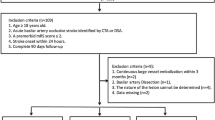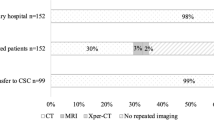Abstract
Purpose
Data on posterior circulation tandem occlusions in acute ischemic stroke are scarce: recognition may be challenging and little is known about optimal treatment strategy. We report our endovascular treatment strategy for posterior circulation tandem occlusion.
Methods
Consecutive patients with posterior circulation tandem occlusions in our centre were enrolled retrospectively. The preferred strategy was “distal-to-proximal” strategy, which means opening the distal occlusion first followed by treatment of the proximal pathology. The imaging characteristics, treatment strategy, clinical outcomes, and complications of patients with posterior circulation tandem occlusions were analyzed.
Results
In total, 21 patients with posterior circulation tandem occlusions were enrolled in the study, which accounted for 23.6% of patients with posterior circulation stroke in our centre. The mean age was 60 years (range 32 to 80), and median pre-procedure NIHSS score was 28 (interquartile range: 13–31). Eighteen patients (85.7%) had vertebrobasilar artery tandem occlusions and 3 (14.3%) had basilar artery to basilar artery tandem occlusions. All distal occlusions were successfully recanalized (modified TICI 2b/3). Two (9.5%) of the proximal lesions were not treated. A total of 57.1% of the patients had stents implanted on the proximal occlusions. The rate of mRS 0–3 at 3 months was 57.1% and the mortality rate was 19.0%.
Conclusion
In patients with acute ischaemic stroke caused by posterior circulation tandem occlusions, we favor “distal-to-proximal” strategy based on the positive results in this small series. Nevertheless, a more extensive study is required to explore the optimal treatment strategy further.



Similar content being viewed by others
References
Grigoryan M, Haussen DC, Hassan AE, Lima A, Grossberg J, Rebello LC, Tekle W, Frankel M, Nogueira RG (2016) Endovascular treatment of acute ischemic stroke due to tandem occlusions: large multicenter series and systematic review. Cerebrovasc Dis 41(5–6):306–312
Malik AM, Vora NA, Lin R, Zaidi SF, Aleu A, Jankowitz BT, Jumaa MA, Reddy VK, Hammer MD, Wechsler LR, Horowitz MB, Jovin TG (2011) Endovascular treatment of tandem extracranial/intracranial anterior circulation occlusions: preliminary single-center experience. Stroke 42(6):1653–1657
Spiotta AM, Lena J, Vargas J, Hawk H, Turner RD, Chaudry MI, Turk AS (2015) Proximal to distal approach in the treatment of tandem occlusions causing an acute stroke. J Neurointervent Surg 7(3):164–169
Puri AS, Kuhn AL, Kwon HJ, Khan M, Hou SY, Lin E, Chueh J, van der Bom IMJ, Dabus G, Linfante I, Gounis MJ, Wakhloo AK (2015) Endovascular treatment of tandem vascular occlusions in acute ischemic stroke. J Neurointervent Surg 7(3):158–163
Marnat G, Mourand I, Eker O, Machi P, Arquizan C, Riquelme C, Ayrignac X, Bonafé A, Costalat V (2016) Endovascular management of tandem occlusion stroke related to internal carotid artery dissection using a distal to proximal approach: insight from the RECOST study. AJNR Am J Neuroradiol 37(7):1281–1288
Lockau H, Liebig T, Henning T, Neuschmelting V, Stetefeld H, Kabbasch C, Dorn F (2015) Mechanical thrombectomy in tandem occlusion: procedural considerations and clinical results. Neuroradiology 57(6):589–598
Wilson MP, Murad MH, Krings T, Pereira VM, Kelly CO, Rempel J, Hilditch CA, Brinjikji W (2018) Management of tandem occlusions in acute ischemic stroke–intracranial versus extracranial first and extracranial stenting versus angioplasty alone: a systematic review and meta-analysis. J NeuroIntervent Surg 10(8):1–9
Siebert E, Bohner G, Zweynert S, Maus V, Mpotsaris A, Liebig T, Kabbasch C (2019) Revascularization techniques for acute basilar artery occlusion: technical considerations and outcome in the setting of severe posterior circulation steno-occlusive disease. Clin Neuroradiol 29(3):435–443
The IMS Study Investigators (2004) Combined intravenous and intra-arterial recanalization for acute ischemic stroke: the interventional management of stroke study. Stroke 35(4):904–911
Hacke W, Zeumer H, Ferbert A, Brückmann H, del Zoppo GJ (1988) Intra-arterial thrombolytic therapy improves outcome in patients with acute vertebrobasilar occlusive disease. Stroke 19(10):1216–1222
Mortimer AM, Bradley M, Renowden S (2012) Endovascular therapy for acute basilar artery occlusion: a review of the literature. J Neurointervent Surg 4(4):266–273
Nagel S, Schellinger PD, Hartmann M, Juettler E, Huttner HB, Ringleb P, Schwab S, Köhrmann M (2009) Therapy of acute basilar artery occlusion: intraarterial thrombolysis alone vs bridging therapy. Stroke 40(1):140–146
Lindsberg PJ, Mattle HP (2006) Therapy of basilar artery occlusion a systematic analysis comparing intra-arterial and intravenous thrombolysis. Stroke 37(3):922–928
Cohen JE, Leker RR, Gomori JM, Eichel R, Rajz G, Moscovici S, Itshayek E (2016) Emergent revascularization of acute tandem vertebrobasilar occlusions: endovascular approaches and technical considerations-confirming the role of vertebral artery ostium stenosis as a cause of vertebrobasilar stroke. J Clin Neurosci 34:70–76
Ecker RD, Tsujiura CA, Baker CB, Cushing D (2014) Endovascular reconstruction of vertebral artery occlusion prior to basilar thrombectomy in a series of six patients presenting with acute symptomatic basilar thrombosis. J Neurointervent Surg 6(5):379–383
Yang HH, Ma N, Zhang SY, Huo XC, Gao F, Sun X, Mo DP, Miao ZR (2018) Endovascular revascularisation of acute tandem vertebrobasilar artery occlusion: seven case series with literature reviews. Stroke Vasc Neurol 3(1):17–21
Papanagiotou P, Haussen DC, Turjman F, Labreuche J, Piotin M, Kastrup A, Steglich-Arnholm H, Holtmannspötter M, Taschner C, Eiden S, Nogueira RG, Boutchakova M, Siddiqui A, Lapergue B, Dorn F, Cognard C, Killer M, Mangiafico S, Ribo M, Psychogios MN, Spiotta A, Labeyrie MA, Biondi A, Mazighi M, Richard S, Anxionnat R, Bracard S, Gory B, TITAN Investigators (2018) Carotid stenting with antithrombotic agents and intracranial Thrombectomy leads to the highest recanalization rate in patients with acute stroke with tandem lesions. JACC Cardiovasc Interv 11(13):1290–1299
Singer OC, Berkefeld J, Nolte CH, Bohner G, Haring HP, Trenkler J, Gröschel K, Müller-Forell W, Niederkorn K, Deutschmann H, Neumann-Haefelin T, Hohmann C, Bussmeyer M, Mpotsaris A, Stoll A, Bormann A, Brenck J, Schlamann MU, Jander S, Turowski B, Petzold GC, Urbach H, Liebeskind DS, ENDOSTROKE Study Group (2015) Mechanical recana1ization in basilar artery occlusion: the ENDOSTROKE study. Ann Neuml 77(3):415–424
Goyal M, Menon BK, van Zwam WH, Dippel DW, Mitchell PJ, Demchuk AM, Dávalos A, Majoie CB, van der Lugt A, de Miquel MA, Donnan GA, Roos YB, Bonafe A, Jahan R, Diener HC, van den Berg L, Levy EI, Berkhemer OA, Pereira VM, Rempel J, Millán M, Davis SM, Roy D, Thornton J, Román LS, Ribó M, Beumer D, Stouch B, Brown S, Campbell BC, van Oostenbrugge R, Saver JL, Hill MD, Jovin TG, HERMES collaborators (2016) Endovascular thrombectomy after large-vessel ischaemic stroke: a meta-analysis of individual patient data from five randomized trials. Lancet 387(10029):1723–1731
Kim YW, Hong JM, Park DG, Choi JW, Kang DH, Kim Y, Zaidat OO, Demchuk AM, Hwang YH, Lee JS (2016) Effect of intracranial atherosclerotic disease on endovascular treatment for patients with acute vertebrobasilar occlusion. AJNR Am J Neuroradiol 37(11):2072–2078
Wen WL, Li ZF, Zhang YW, Yang PF, Simfukwe K, Fang YB, Zhang TY, Deng BQ, Hong B, Liu JM, Huang QH (2017) Effect of baseline characteristics on the outcome of stent retriever based thrombectomy in acute basilar artery occlusions-a single center experience and pooled-data analysis. World Neurosurg 104:1–8
Fan Y, Li Y, Zhang T, Li X, Yang J, Wang B, Jiang C (2018) Endovascular therapy for acute vertebrobasilar occlusion underlying atherosclerosis: a single institution experience. Clin Neurol Neurosurg 176:78–82
Lee JS, Hong JM, Lee KS, Suh HI, Demchuk AM, Hwang YH, Kim BM, Kim JS (2015) Endovascular therapy of cerebral arterial occlusions: intracranial atherosclerosis versus embolism. J Stroke Cerebrovasc Dis 24(9):2074–2080
Schonewille WJ, Wijman CA, Michel P, Rueckert CM, Weimar C, Mattle HP, Engelter ST, Tanne D, Muir KW, Molina CA, Thijs V, Audebert H, Pfefferkorn T, Szabo K, Lindsberg PJ, de Freitas G, Kappelle LJ, Algra A, BASICS study group (2009) Treatment and outcomes of acute basilar artery occlusion in the basilar artery international cooperation study (BASICS): a prospective registry study. Lancet Neurol 8(8):724–730
Imai K, Mori T, Izumoto H, Kunieda T, Takabatake N, Yamamoto S, Watanabe M (2008) Transluminal angioplasty and stenting for intracranial vertebrobasilar occlusive lesions in acute stroke patients. AJNR Am J Neuroradiol 29(4):773–780
Berkhemer OA, Borst J, Kappelhof M et al (2017) Extracranial carotid disease and effect of intra-arterial treatment in patients with proximal anterior circulation stroke in MR CLEAN. Ann Intern Med 166(12):1–9
Al-Ali F, Barrow T, Duan L, Jefferson A, Louis S, Luke K, Major K, Smoker S, Walker S, Yacobozzi M (2011) Vertebral artery ostium atherosclerotic plaque as a potential source of posterior circulation ischemic stroke: result from borgess medical center vertebral artery ostium stenting registry. Stroke 42(9):2544–2549
Caplan LR, Wityk RJ, Glass TA, Tapia J, Pazdera L, Chang HM, Teal P, Dashe JF, Chaves CJ, Breen JC, Vemmos K, Amarenco P, Tettenborn B, Leary M, Estol C, Dewitt LD, Pessin MS (2004) New England Medical Center posterior circulation registry. Ann Neurol 56(3):389–398
Voetsch B, DeWitt LD, Pessin MS, Caplan LR (2004) Basilar artery occlusive disease in the new England Medical Center posterior circulation stroke registry. Arch Neurol 61(4):496–504
Wang YJ, Zhao XQ, Liu LP, Soo YOY, Pu YH, Pan YS, Wang YL, Zou XY, Leung TWH, Cai YF, Bai Q, Wu YP, Wang CX, Pan XP, Luo BY, Wong KSL (2014) Prevalence and outcomes of symptomatic intracranial large artery stenoses and occlusions in China: the Chinese intracranial atherosclerosis (CICAS) study. Stroke 45(3):663–669
Heck DV, Brown MD (2015) Carotid stenting and intracranial thrombectomy for treatment of acute stroke due to tandem occlusions with aggressive antiplatelet therapy may be associated with a high incidence of intracranial haemorrhage. J NeuroIntervent Surg 7(3):170–175
Kappelle LJ, Philipps J (2005) Emergency administration of abciximab for treatment of patients with acute ischemic stroke. Results of a randomized phase 2 trial. Stroke 36(4):880–890
Li W, Lin L, Zhang M, Wu Y, Liu C, Li X, Huang S, Liang C, Wang Y, Chen J, Feng W (2016) Safety and preliminary efficacy of early tirofiban treatment after alteplase in acute ischemic stroke patients. Stroke 47(10):2649–2651
Pancioli AM, Adeoye O, Schmit PA, Khoury J, Levine SR, Tomsick TA, Sucharew H, Brooks CE, Crocco TJ, Gutmann L, Hemmen TM, Kasner SE, Kleindorfer D, Knight WA, Martini S, McKinney J, Meurer WJ, Meyer BC, Schneider A, Scott PA, Starkman S, Warach S, Broderick JP, CLEAR-ER Investigators (2013) Combined approach to lysis utilizing eptifibatide and recombinant tissue plasminogen activator in acute ischemic stroke-enhanced regimen stroke trial. Stroke 44(9):2381–2387
Siebler M, Hennerici MG, Schneider D, von Reutern GM, Seitz RJ, Röther J, Witte OW, Hamann G, Junghans U, Villringer A, Fiebach JB (2011) Safety of tirofiban in acute ischemic stroke: the SaTIS trial. Stroke 42(9):2388–2392
Kang DH, Kim YW, Hwang YH, Park SP, Kim YS, Baik SK (2014) Instant reocclusion following mechanical thrombectomy of in situ thromboocclusion and the role of low-dose intra-arterial tirofiban. Cerebrovasc Dis 37(5):350–355
Torgano G, Zecca B, Monzani V, Maestroni A, Rossi P, Cazzaniga M, Manganaro D, Boiti C, Zilioli E, Borutti G, Falaschi F, Mandelli C (2010) Effect of intravenous tirofiban and aspirin in reducing short-term and long-term neurologic deficit in patients with ischemic stroke: a double-blind randomized trial. Cerebrovasc Dis 29(3):275–281
Acknowledgments
We are grateful to the clinicians and staff at the Changhai Hospital of Second Military Medical University for their contribution to medical intervention and data collection.
Funding
This study was funded by the Project of Research and Application of Effective Intervention Techniques for High-Risk Stroke Population of China in 2017 (GN-2017R0001).
Author information
Authors and Affiliations
Corresponding author
Ethics declarations
Conflict of interest
We declare that there are no conflicts of interest in this paper.
Ethical approval
For this type of study formal consent is not required.
Informed consent
Informed consent was obtained from all individual participants included in this study.
Additional information
Publisher’s note
Springer Nature remains neutral with regard to jurisdictional claims in published maps and institutional affiliations.
Rights and permissions
About this article
Cite this article
Xing, Pf., Zhang, Yw., Li, Zf. et al. The “distal-to-proximal” strategy for the treatment of posterior circulation tandem occlusions: a single-centre experience. Neuroradiology 62, 867–876 (2020). https://doi.org/10.1007/s00234-020-02412-0
Received:
Accepted:
Published:
Issue Date:
DOI: https://doi.org/10.1007/s00234-020-02412-0




